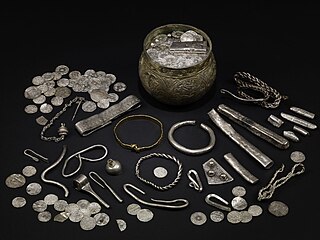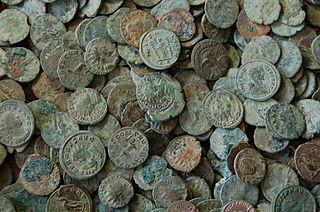2000
On 25 July 2000, John and David Philpott discovered a hoard of 1,166 coins (mostly silver siliquae) near Wilcot. The Stanchester Hoard, as it is now known, is in the Wiltshire Museum.

A number of Roman hoards have been discovered near Pewsey and Wilcot in the Vale of Pewsey, Wiltshire, England.
On 25 July 2000, John and David Philpott discovered a hoard of 1,166 coins (mostly silver siliquae) near Wilcot. The Stanchester Hoard, as it is now known, is in the Wiltshire Museum.

From January to April 2014, Nick Barrett discovered 42 clipped silver siliquae. The find has been designated by the Portable Antiquities Scheme as WILT-B53A45. [1]
In May 2014, Russell Garman discovered a coin hoard of 2,384 coins, mostly nummi. It has been designated by the Portable Antiquities Scheme as BERK-637CB6. [2]
On 26 October 2014, Rob Abbot, Dave Allen, and Mick Rae discovered a hoard of eight Roman copper-alloy vessels packed inside an iron-rimmed cauldron. This has been designated by the Portable Antiquities Scheme as WILT-0F898C. The vessels are now in the Salisbury Museum. [3]

A hoard consisting of a bowl strainer, two basins and a bowl was found at Wilcot in 2017. It has been designated by the Portable Antiquities Scheme as WILT-047110. [4]
On 12 and 13 September 2020, Rob Abbot, Dave Allen and Mick Rae (who had made a discovery in 2014) found a total of 160 silver (and one copper) coins: 23 miliarenses and 137 siliquae, from Constans to Honorius. It was designated by the Portable Antiquities Scheme as BM-7D34D9. [3] Two of the coins went to the British Museum, and most of the rest were auctioned by Noonans Mayfair: they were expected to fetch £40,000 but ended up making £81,160. [5] [6]

The Vale of Pewsey or Pewsey Vale is an area of Wiltshire, England to the east of Devizes and south of Marlborough, centred on the village of Pewsey.

The Hoxne Hoard is the largest hoard of late Roman silver and gold discovered in Britain, and the largest collection of gold and silver coins of the fourth and fifth centuries found anywhere within the Roman Empire. It was found by Eric Lawes, a metal detectorist in the village of Hoxne in Suffolk, England in 1992. The hoard consists of 14,865 Roman gold, silver, and bronze coins and approximately 200 items of silver tableware and gold jewellery. The objects are now in the British Museum in London, where the most important pieces and a selection of the rest are on permanent display. In 1993, the Treasure Valuation Committee valued the hoard at £1.75 million.

The Vale of York Hoard, also known as the Harrogate Hoard and the Vale of York Viking Hoard, is a 10th-century Viking hoard of 617 silver coins and 65 other items. It was found undisturbed in 2007 near the town of Harrogate in North Yorkshire, England. The hoard was the largest Viking one discovered in Britain since 1840, when the Cuerdale hoard was found in Lancashire, though the Anglo-Saxon Staffordshire Hoard, found in 2009, is larger.

Manningford is a civil parish in Wiltshire, England. The parish includes the villages of Manningford Abbots, Manningford Bohune and Manningford Bruce, and the hamlet of Manningford Bohune Common, together known as the Manningfords.
The Treasure Valuation Committee (TVC) is an advisory non-departmental public body of the Department for Culture, Media and Sport (DCMS) based in London, which offers expert advice to the government on items of declared treasure in England, Wales, and Northern Ireland that museums there may wish to acquire from the Crown.

The Frome Hoard is a hoard of 52,503 Roman coins found in April 2010 by metal detectorist Dave Crisp near Frome in Somerset, England. The coins were contained in a ceramic pot 45 cm (18 in) in diameter, and date from AD 253 to 305. Most of the coins are made from debased silver or bronze. The hoard is one of the largest ever found in Britain, and is also important as it contains the largest group ever found of coins issued during the reign of Carausius, who ruled Britain independently from 286 to 293 and was the first Roman Emperor to strike coins in Britain. The Museum of Somerset in Taunton, using a grant from the National Heritage Memorial Fund (NHMF), acquired the hoard in 2011 for a value of £320,250.
The Stanchester Hoard is a hoard of 1,166 Roman coins dating from the fourth to early fifth century found in 2000 at Wilcot, in the Vale of Pewsey, Wiltshire, England. The find was considered important because of the large quantity of unclipped silver coins contained within. It was also the latest dated example of Roman coins found in Wiltshire.

The Shapwick Hoard is a hoard of 9,262 Roman coins found at Shapwick, Somerset, England in September 1998. The coins dated from as early as 31–30 BC up until 224 AD. The hoard also notably contained two rare coins which had not been discovered in Britain before, and the largest number of silver denarii ever found in Britain.

The Shrewsbury Hoard is a hoard of 9,315 bronze Roman coins discovered by a metal detectorist in a field near Shrewsbury, Shropshire in August 2009. The coins were found in a large pottery storage jar that was buried in about AD 335.

Wilcot is a village in Wiltshire, England, in the Vale of Pewsey about 6 miles (10 km) southwest of Marlborough and 1.5 mi (2.4 km) northwest of Pewsey.

The Bredon Hill Hoard is a hoard of 3,784 debased silver Roman coins discovered in June 2011 by two metal detectorists on Bredon Hill in Worcestershire, approximately 400 metres north of Kemerton Camp, an Iron Age hill fort. The coins were found in a clay pot that had been buried around the middle of the 4th century in a Roman villa, identified by the subsequent archaeological excavation. The coins include the reigns of sixteen different emperors during the mid to late 3rd century, and are the largest hoard of Roman coins to have been discovered in Worcestershire to date.

The Silverdale Hoard is a collection of over 200 pieces of silver jewellery and coins discovered near Silverdale, Lancashire, England, in September 2011. The items were deposited together in and under a lead container buried about 16 inches (41 cm) underground which was found in a field by a metal detectorist. It is believed to date to around AD 900, a time of intense conflict between the Anglo-Saxons and the Danish settlers of northern England. The hoard is one of the largest Viking hoards ever discovered in the UK. It has been purchased by Lancashire Museums Service and has been displayed at Lancaster City Museum and the Museum of Lancashire in Preston. It is particularly significant for its inclusion of a coin stamped with the name of a previously unknown Viking ruler.

The Seaton Down Hoard is a hoard of 22,888 Roman coins found in November 2013 by metal detectorist Laurence Egerton near Seaton Down in Devon, England.
The Lenborough Hoard is a hoard of more than 5,000 late Anglo-Saxon silver coins, dating to the eleventh century, that was found at Lenborough in Buckinghamshire, England in 2014. It is believed to be one of the largest hoards of Anglo-Saxon coins ever found in Britain.
Philippa Mary Pearce is a senior conservator at the British Museum. She is particularly known for her work on coin hoards found in England and was awarded an MBE for services to metal conservation in 2018. She has worked on most of the coin hoards found in recent years as part of the Treasure process.
Andrew R. Woods is a British numismatist, archaeologist and curator specialising in early medieval and Viking coinage. He is the senior curator of the Yorkshire Museum and was formerly the curator of numismatics at the York Museums Trust.

Noonans Mayfair, formerly Dix Noonan Webb, is an auction house based in London. It specialises in coins, medals, jewellery and paper money.